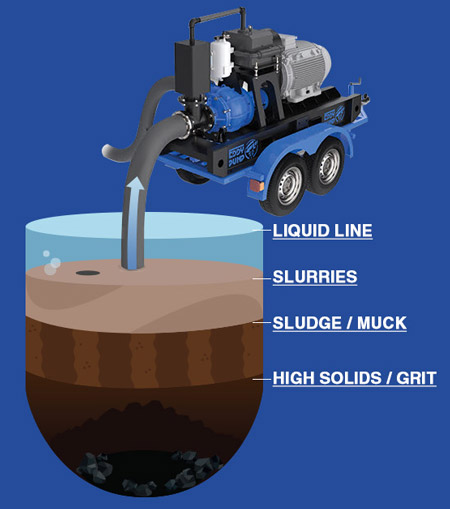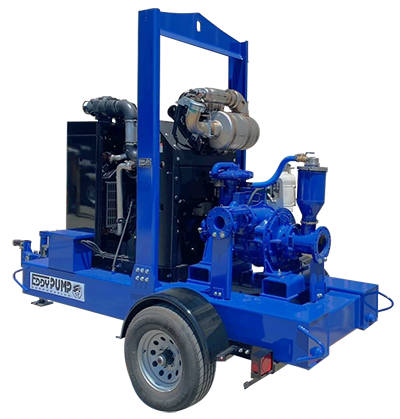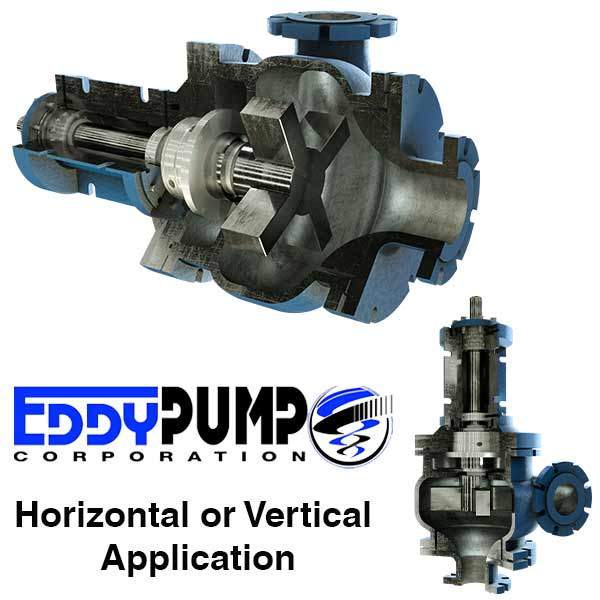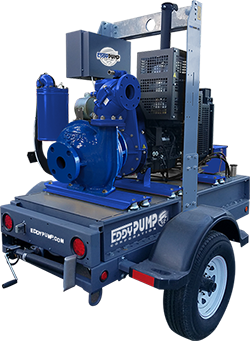Self-Priming Slurry Pumps
EDDY self-priming slurry pumps are able to draw liquid into their suction hose, even if the pump and the liquid are not already submerged in the liquid.
Our self-priming slurry pumps are specifically designed for handling heavy-duty industrial and mining applications where a consistent flow of abrasive and corrosive materials is required. The unique design of the pumps allows them to self-prime, eliminating the need for a separate priming system and reducing downtime.
Constructed with durable materials such as high-chromium alloys, our self-priming sludge pumps ensure a long service life with minimal maintenance. They are also able to operate in a wide range of temperatures and pressures, making them suitable for a variety of industrial applications.
To know everything about diesel engine-driven self-priming pumps, check out our blog here.
Self-Priming Slurry Pump Guide
Compare specifications
| Model | Size | Power | Flow Rate | Head | PDF |
|---|---|---|---|---|---|
| 3-Inch 43HP Self-Priming Pump (Diesel) | 3-inch | 43 HP | 100 - 780 GPM | up to 130 ft | ENG |
| 4-Inch 43HP Self Priming Pump (Diesel) | 4-inch | 43 HP | 250 - 1200 GPM | up to 200 ft | ENG |
| 4-Inch 115HP Self Priming Pump (Diesel) | 4-inch | 115 HP | 250 - 1200 GPM | up to 200 ft | ENG |
| 6-Inch 115HP Self Priming Pump (Diesel) | 6-inch | 115 HP | 450-2000 GPM | up to 200 ft | ENG |
| 6-Inch 173HP Self Priming Pump (Diesel) | 6-inch | 173 HP | 450 - 2000 GPM | up to 200 ft | ENG |
| 8-Inch 550HP Self Priming Pump (Diesel) | 8-inch | 550 HP | 1400 - 3600 GPM | up to 230 ft | ENG |
| 10-Inch 550HP Self Priming Pump (Diesel) | 10-inch | 550 HP | 1600 - 5000 GPM | up to 240 ft | ENG |
| 12-Inch 700HP Self Priming Pump (Diesel) | 12-inch | 700 HP | 2600 - 7300 GPM | up to 180 ft | ENG |
ANY SELF PRIMING PUMP CAN DELIVER
But Only the EDDY Self-Priming Slurry Pump Can Move Solids That Destroy All Other Pumps.
PUMP HIGHLY VISCOUS MATERIALS WITH LOW DOWNTIME
The diesel driven self-priming pump incorporates a vacuum-assisted priming unit with the pump. This fills the pump with slurry or target material, which allows the main EDDY Pump to work.
DRY PRIME CAPABILITY WITH UNIQUE SEAL SUPPORT SYSTEM
Most EDDY Pumps are submersible; however, with a self-priming unit, the pump and power unit are not submerged. The suction hose goes into the slurry, making the unit like a super-sized wet vacuum.
MAIN APPLICATIONS:
Mining, Sand/Agg, Sewage/Wastewater, Chemical, Irrigation, Sump Pit Cleanouts, Digester Tanks, Dewatering, and More!

Self-Priming Slurry Pump DEPLOYEMENT

Skid Mounted Self-Priming Slurry Pump
A skid-mounted self-priming slurry pump is a pump that is mounted on a skid or platform. Skid-mounted pumps are designed to be fully self-contained and pre-piped, which makes the installation process much simpler and faster. This can help to reduce downtime and minimize the costs associated with installing a new pumping system.
These pumps are often used in applications where it is not practical or possible to use a traditional pump, such as in remote locations or where there is limited access to power.

Trailer Mounted Self-Priming Slurry Pump
A trailer-mounted self-priming slurry pump is a pump that is mounted on a trailer. The trailer-mounted design makes it easy to transport the pump to different locations as needed.
Trailer-mounted pumps are cost-effective as they combine mobility and versatility, with an efficient and powerful pumping system in one compact unit, which eliminates the need for additional components and accessories.

Self-Priming Slurry Pumps Advantage
- EDDY Power in a Self-Priming Package
- Secondary Vacuum Pump Allows Constant Priming
- Works Like a Giant Wet Vac
- Move 30-70% Solids
- Powered by Electric or Diesel
- Non-Clog, High Viscosity, High Specific Gravity,
High Abrasives, Low pH Pumping Design - Easily Process Rags, String, Rocks and Foreign Objects That Frequently Clog Other Pumps
- Multiple Mounting Options (Skid, Trailer, Stationary)
Why Self-Priming Slurry Pumps are better – highlights
This video shows how EDDY Pump beats out traditional centrifugal pumps regarding tough slurry and abrasive materials. EDDY Pump is at the heart of our featured dredge pump equipment, including the Remote Operated Subdredge, Diver Operated Pump, and the Excavator Attachment Dredge Pump. More Videos HERE.
What Is A Self-priming Slurry Pump?

A self-priming slurry pump can pump liquids and solids without needing a separate priming pump. These pumps are designed with an internal air chamber that allows them to draw in air and liquid, creating a partial vacuum that helps prime the pump. This eliminates the need for a separate priming pump, which can be expensive and time-consuming.
Self-priming slurry pumps are commonly used in various industries, including mining, oil and gas, chemical processing, and wastewater treatment. They are instrumental in applications where the suction lift (the vertical distance the pump must lift the slurry from the source to the pump) is relatively high, as traditional slurry pumps may struggle to raise the slurry on their own.
Self-priming slurry pumps are typically more expensive than traditional slurry pumps. Still, they can offer significant cost savings in the long run by eliminating the need for a separate priming pump. They are also typically more reliable and easier to maintain than traditional slurry pumps, as they do not require frequent priming and de-priming.
Applications for Self-Priming Slurry Pumps
Self-priming slurry pumps are commonly used in various industries and applications where the suction lift (the vertical distance the pump must lift the slurry from the source to the pump) is relatively high. Some examples of applications for self-priming slurry pumps include:
- Mining: Self-priming slurry pumps are often used in mining operations to pump abrasive slurry, such as tailings or ore slurry, from one location to another.
- Oil and gas: Self-priming slurry pumps are used in the oil and gas industry to pump slurry and other fluids, such as drilling mud, from the well to the surface.
- Chemical processing: These pumps are used in chemical plants to pump corrosive slurries and other fluids.
- Wastewater treatment: Self-priming slurry pumps are often used in wastewater treatment plants to pump sludge and other solids from one location to another.
- Flood control: Self-priming slurry pumps can pump floodwater and other fluids from low-lying areas to prevent damage to buildings and infrastructure.
- Dredging: These pumps are used in dredging operations to remove sediment and other materials from bodies of water.
- Agriculture: Self-priming slurry pumps can be used to pump slurry and other fluids, such as manure and fertilizers, from one location to another.
Overall, self-priming slurry pumps are helpful in many industries and applications where traditional slurry pumps may struggle to lift the slurry on their own.

Issues with Self-Priming Slurry Pumps
Self-priming slurry pumps are generally reliable and efficient, but like any mechanical equipment, they can experience issues. Some common problems that may occur with self-priming slurry pumps include the following:
- Clogging: Self-priming slurry pumps can become clogged if the slurry contains too many solids or if the pump needs to be sized correctly for the application. This can reduce the efficiency of the pump and may require frequent maintenance.
- Cavitation: Cavitation occurs when the pump’s suction becomes too low, causing air bubbles in the slurry. These bubbles can collapse and create high-pressure areas that can damage the pump’s impeller and other components.
- Wear and tear: Self-priming slurry pumps are designed to handle abrasive and corrosive slurries, but over time, the constant exposure to these materials can cause wear and tear on the pump’s components. This can reduce the pump’s efficiency and require frequent maintenance or repairs.
- Air leakage: If the air chamber in a self-priming slurry pump develops a leak, it may be unable to create a partial vacuum and prime the pump. This can reduce the efficiency of the pump and may require repairs.
To minimize these issues, it is essential to size and maintains self-priming slurry pumps appropriately and to use them within their recommended operating parameters. Regular inspection and maintenance can help identify and address potential issues before they become significant problems.
Self-Priming Slurry Pumps FOR DEWATERING
This Video shows a smaller electric 3-Inch EDDY Self-Prime flowing at 400 GPM (2 cu yd) of slurry at distances of 400 ft in under a minute.
4-inch and 6-inch Diesel Trailer Units Are Most Popular
The core of this design is the patented EDDY Pump technology. The design redefines the pumping industry by being the only pump that utilizes the principles of a tornado to create a synchronized eddy current. This pump is not a centrifugal, positive displacement, or vortex pump but the most highly efficient high solids and high specific gravity pump on the market.
An ideal system for pumping the most viscous and heavy materials without clogging or having significant downtime. Lower downtime and maintenance issues versus conventional centrifugal or positive displacement pumps will save your project money. Pump size options range from the 2-inch slurry pump to a 12-inch option. Our system handles pumping distances over 3500 feet and production rates up to 4000 GPM.
SELF-PRIME FLEET RETROFITS
Get EDDY Pump Technology in a Diesel Self-Prime Format.
Boost your Solids Pumping Production!
We understand the importance of maintaining efficient and reliable operations, but sometimes older pump systems can become a bottleneck. That’s why we offer to retrofit services to upgrade your existing pumps to state-of-the-art EDDY Pumps.
EDDY Pumps are known for their ability to handle abrasive and corrosive materials with ease, making them perfect for a variety of industrial and mining applications. The unique design of the pump’s impeller and volute allows it to handle a high percentage of solids, without clogging or jamming.
Retrofitting your old pump with an EDDY Pump can increase efficiency and performance, while also reducing downtime and maintenance costs. Our team of experts will work with you to determine the best retrofit solution for your specific needs, ensuring a seamless and efficient upgrade process.
EXCAVATOR ALTERNATIVE DEPLOYMENT
SELF-PRIME EXCAVATOR CONFIGURATION
Unlock maximum efficiency and power with our self-priming pump and EDDY Pump excavator attachment combo!
Our self-priming pumps are specially designed to handle heavy-duty industrial and mining applications where a consistent flow of abrasive and corrosive materials is required. The unique design of the pumps allows them to self-prime, eliminating the need for a separate priming system and reducing downtime.
When combined with our EDDY Pump excavator attachment, the result is a powerful and efficient pumping system that can handle the most demanding conditions. The EDDY Pump excavator attachment is specifically designed to be attached to an excavator’s arm, allowing for easy mobility and versatile use on different sites. This unique design allows the pump to handle high percentages of solids and debris without clogging or jamming, which is perfect for mining, dredging, and other industrial applications.
This combination of self-priming pump and EDDY pump excavator attachment allows for maximum efficiency and performance in any harsh environment and allows you to save time and resources while reducing downtime and maintenance costs.

Self-Prime Recirculation Pump System
Keeping viscous slurries mixed helps prevent the settling of high solids sludge and slurries with low downtimes. Learn more…
Keep your holding tanks clean and efficient with our NOEX® recirculation pump system!
Holding tanks are an essential part of many industrial and commercial operations, but keeping them clean and maintaining the quality of the liquid stored can be a challenging task. Our recirculation pumps offer a solution to this problem by continuously circulating the liquid in the tank, promoting a homogenous mixture and reducing the risk of sedimentation and corrosion.
Our NOEX® Slurry Recirculation Pumps are designed for heavy-duty use and can handle a wide range of liquids including abrasive and corrosive fluids. The pumps are constructed with durable materials, such as high-chromium alloys, to ensure a long service life and minimal maintenance. The pumps are also customizable, with a variety of options available to suit your specific needs.
HD (Heavy Duty) Slurry Pumps
HD (Heavy Duty) Slurry Pumps

Dredge Pumps, Process, Slurry and Marine Pumps
And Dredging Equipment OEM
Why EDDY Pumps Are Better
How The EDDY Pump Works

We are a US dredge equipment and commercial slurry pump manufacturer. Only EDDY Pump equipment is sold here.
EDDY Pumps patented pump technology outperforms all centrifugal, vortex and positive displacement pumps in a variety of the most challenging pumping applications, especially pumping applications moving 40-70% solids. Our pump design allows for longer intervals between maintenance, which translates to increased output, uptime, and higher profits. Learn more about our products below, and pick a product line that fits your project needs.
Call us at 619-404-1916 if you need assistance.
ALL OF OUR EQUIPMENT IS POWERED BY THE EDDY PUMP
One Pump for Process, Slurry, Sludge, Wastewater, and Dredging.

Get Expert Selection Help
Rent or Buy, Excavator Attachment Pumps and Slurry Pumps for Dredging.
Applications Include: Sand & Gravel, Mining, Commercial Food Processing, Sewage, Waste Water and Drilling Mud.
Frequently Asked Questions
What is a self-priming slurry pump?
A self-priming slurry pump is designed to handle abrasive and viscous fluids like slurry. It can prime itself, creating a vacuum to draw fluid into the pump without the need for manual priming.
How does a self-priming slurry pump work?
A self-priming slurry pump typically has an air-water separation or priming chamber. When the pump starts, it evacuates air from the suction line, creating a vacuum that allows the slurry to be drawn into the pump. Once the pump is primed, it operates like a standard centrifugal pump.
What are the advantages of using a self-priming slurry pump?
The main advantages include ease of use, as manual priming is not required; versatility in handling different types of slurries; and the ability to handle air entrainment in the fluid.
Can self-priming slurry pumps handle solids?
Self-priming slurry pumps are designed to handle fluids with high solid content. The size of solids that can be handled depends on the pump’s design and size.
What are the applications of self-priming slurry pumps?
These pumps are commonly used in mining, construction, wastewater treatment, and industrial processing where handling abrasive or viscous fluids is required.
How do I choose the right self-priming slurry pump for my application?
Consider factors such as the type and concentration of slurry, the size of solids, the required flow rate and head, and the suitable construction material for your application.
How do I maintain a self-priming slurry pump?
Regular maintenance includes checking for wear on the impeller and casing, ensuring the priming chamber is functioning correctly, monitoring bearing and seal conditions, and keeping the suction and discharge lines clear.
What are the limitations of self-priming slurry pumps?
They may have maximum head and efficiency limitations compared to standard centrifugal pumps. Additionally, they may require more frequent maintenance due to the abrasive nature of the fluids they handle.
Can self-priming slurry pumps run dry?
While self-priming pumps can handle short periods of dry running during the priming phase, prolonged dry running can damage the pump.
Are self-priming slurry pumps more expensive than standard slurry pumps?
The initial cost might be higher due to their self-priming capability, but the ease of installation and reduced maintenance requirements can offset the higher initial investment over time.




